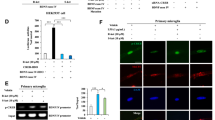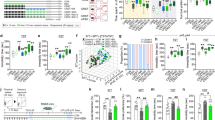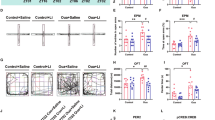Abstract
Various effects of antidepressant drugs on gene transcription have been described and altered gene expression has been proposed as being a common biological basis underlying depressive illness. One target for the common action of antidepressants is a modifying effect on the regulation of postreceptor pathways and genes related to the cAMP cascade. Recent studies have demonstrated that long-term antidepressant treatment resulted in sustained activation of the cyclic adenosine 3′,5′-monophosphate system and in increased expression of the transcription factor cAMP response element binding protein (CREB). A transgenic animal model of depression with impaired glucocorticoid receptor function was used to investigate the effect of chronic antidepressant treatments on CREB expression in different brain areas. Wild-type and transgenic mice received one administration of saline, desipramine, or fluoxetine, daily for 21 days. The effects of antidepressants on CREB mRNA were analyzed using a sensitive RNase protection assay. Antidepressant treatment resulted in a neuroanatomically and animal specific expression pattern of CREB. Our findings suggest that life-long central glucocorticoid receptor dysfunction results in an altered sensitivity with respect to the effects of antidepressants on the expression of CREB.
Similar content being viewed by others
Log in or create a free account to read this content
Gain free access to this article, as well as selected content from this journal and more on nature.com
or
References
Barden N . (1996): Modulation of glucocorticoid receptor gene expression by antidepressant drugs. Pharmacopsychiatry 29: 12–22
Barden N, Reul JMHM, Holsboer F . (1995): Do antidepressants stabilize mood through actions on the hypothalamus-pituitary-adrenocortical system? Trends Neurosci 18: 6–11
Barden N, Stec ISM, Montkowski A, Holsboer F, Reul JMHM . (1997): Endocrine profile and neuroendocrine challenge tests in transgenic mice expressing antisense RNA against the glucocorticoid receptor. Neuroendocrinology 66: 212–220
Bito H, Deisseroth K, Tsien RW . (1996): CREB phosphorylation and dephosphorylation: a Ca2+- and stimulus duration-dependent switch for hippocampal gene expression. Cell 87: 1203–1214
Blendy JA, Kaestner KH, Schmid W, Gass P, Schutz G . (1996): Targeting of the CREB gene leads to up-regulation of a novel CREB mRNA isoform. EMBO Journal 15: 1098–1106
Blier P, de Montigny C . (1994): Current advances and trends in the treatment of depression. Trends Pharm Sci 15: 220–226
Chen ACH, Shirayama Y, Shin KH, Neve RL, Duman RS . (2001): Expression of cAMP element binding protein (CREB) in hippocampus produces an antidepressant effect. Biol Psychiatry 49: 753–762
Chomczynski P, Sacchi N . (1987): Single step method of RNA isolation by guanidium thiocyanate chloroform extraction. Anal Biochem 162: 156–159
Dijkstra I, Tilders FJH, Aguilera G, Kiss A, Rabadandiehl C, Barden N, Karanth S, Holsboer F, Reul JMHM . (1998): Reduced activity of hypothalamic corticotropin-releasing hormone neurons in transgenic mice with impaired glucocorticoid receptor function. J Neuroscience 18: 3909–3918
Dowlatshahi D, MacQueen GM, Wang JF, Young LT . (1998): Increased temporal cortex CREB concentrations and antidepressant treatment in major depression. Lancet 352: 1754–1755
Duman RS, Heninger GR, Nestler EJ . (1997): A molecular and cellular theory of depression. Arch Gen Psychiatry 54: 597–606
Duman RS, Malberg J, Thome J . (1999): Neural plasticity to stress and antidepressant treatment. Biol Psychiatry 46: 1181–1191
Frechilla D, Otano A, Del Rio J . (1998): Effect of chronic antidepressant treatment on transcription factor binding activity in rat hippocampus and frontal cortex. Progr Neuro-Psychopharmacol & Biol Psychiatry 22: 787–802
Fujimaki K, Morinobu S, Duman RS . (2000): Administration of a cAMP phosphodiesterase 4 inhibitor enhances antidepressant-induction of BDNF mRNA in rat hippocampus. Neuropsychopharmacology 22: 42–51
Ghosh A, Greenberg ME . (1995): Calcium signaling in neurons: molecular mechanisms and cellular consequences. Science 268: 239–247
Gonzalez GA, Montminy MR . (1989): Cyclic AMP stimulates somatostatin gene transcription by phosphorylation of CREB at serine 133. Cell 59: 675–680
Hatalski CG, Baram TZ . (1997): Stress-induced transcriptional regulation in the developing rat brain involves increased cyclic adenosine 3′,5′-monophosphate-regulatory element binding activity. Mol Endocrinol 11: 2016–2024
Holsboer F, Barden N . (1996): Antidepressants and hypothalamic pituitary adrenocortical regulation. Endocrine Rev 17: 187–205
Holsboer F . (2000): The Corticosteroid Receptor Hypothesis of Depression. Neuropsychopharmacology 23: 477–501
Karanth S, Lindhorst AC, Stalla K, Barden N, Holsboer F, Reul JM . (1997): Hypothalamic-pituitary-adrenocortical axis changes in a transgenic mouse model with impaired glucocorticoid receptor function. Endocrinology 138: 3476–3485
Lamas M, Sassone-Corsi P . (1997): The dynamics of the transcriptional response to cyclic adenosine 3′,5′-monophosphate: recurrent inducibility and refractory phase. Mol Endocrinol 11: 1415–1424
Legradi G, Holzer D, Kapcala LP, Lechan RM . (1997): Glucocorticoids inhibit stress-induced phosphorylation of CREB in corticotropin-releasing hormone neurons of the hypothalamic paraventricular nucleus. Neuroendocrinology 66: 86–97
Meyer TE, Habener JF . (1993): Cyclic adenosine 3′,5′-monophosphate response element binding protein (CREB) and related transcription-activating deoxyribonucleic acid-binding proteins. Endocrine Rev 14: 269–290
Montminy MR, Gonzalez GA, Yamamoto KK . (1990): Regulation of cAMP-inducible genes by CREB. Trends Neurosci 13: 184–188
Nestler EJ, Terwilliger RZ, Duman RS . (1989): Chronic antidepressant administration alters the subcellular distribution of cyclic AMP-dependent protein kinase in rat frontal cortex. J Neurochem 53: 1644–1647
Nibuya M, Nestler EJ, Duman RS . (1996): Chronic antidepressant administration increases the expression of cAMP response element binding protein (CREB) in rat hippocampus. J Neurosci 16: 2365–2372
O'Donnell JM . (1993): Antidepressant-like effects of rolipram and other inhibitors of cyclic AMP phosphodiesterase on behavior maintained by differential reinforcement of low response rate. J Pharmacol Exp Ther 264: 1168–1178
Ozawa H, Rasenick MM . (1991): Chronic electroconvulsive treatment augments coupling of the GTP-binding protein Gs to the catalytic moiety of adenylyl cyclase in a manner similar to that seen with chronic antidepressant drugs. J Neurochem 56: 330–338
Pariante CM, Miller AH . (2001): Glucocorticoid receptors in major depression: relevance to pathophysiology and treatment. Biol Psychiatry 9: 391–404
Pepin MC, Pothier F, Barden N . (1992a): Impaired Type II glucocorticoid-receptor function in mice bearing antisense RNA transgene. Nature 355: 725–728
Pepin MC, Pothier F, Barden N . (1992b): Antidepressant drug action in a transgenic mouse model of the endocrine changes seen in depression. Mol Pharmacology 42: 991–995
Pietruck C, Xie G-X, Sharma M, Meuser T, Pierce Palmer P . (1999): Multiple splice patterns of cyclic AMP response element-binding protein mRNA in the central nervous system of the rat. Mol Brain Res 69: 286–289
Popoli M, Brunello N, Perez J, Racagni G . (2000): Second messenger-regulated protein kinases in the brain: their functional role and the action of antidepressant drugs. J Neurochemistry 74: 21–33
Sassone-Corsi P . (1995): Transcription factors responsive to cAMP. Ann Rev Cell & Dev Biol 11: 355–377
Shaywitz AJ, Greenberg ME . (1999): CREB: A stimulus-induced transcription factor activated by a diverse array of extracellular signals. Ann Rev Biochem 68: 821–861
Shelton RC, Manier DH, Sulser F . (1996): cAMP-dependent protein kinase activity in major depression. Am J Psychiatry 153: 1037–1042
Sheng M, Thompson MA, Greenberg ME . (1991): CREB: a ca2+-regulated transcription factor phosphorylated by calmodulin-dependent kinases. Science 252: 1427–1430
Takahashi M, Terwilliger R, Lane C, Mezes PS, Conti M, Duman R . (1999): Chronic antidepressant administration increases the expression of cAMP-specific phosphodiesterase 4A and 4B isoform. J Neurosci 19: 610–618
Thome J, Sakai N, Shin K-H, Steffen C, Zhang Y-J, Impey S, Storm D, Duman RS . (2000): cAMP response element-mediated gene transcription is upregulated by chronic antidepressant treatment. J Neurosci 20: 4030–4036
Acknowledgements
We thank Dr. Schütz for kindly providing the CREB cDNA. The authors also thank Stefania Gibertini and Paolo Muzzioli for their assistance and Ivo Ibba for excellent technical support.
Author information
Authors and Affiliations
Corresponding author
Rights and permissions
About this article
Cite this article
Blom, J., Tascedda, F., Carra, S. et al. Altered Regulation of CREB by Chronic Antidepressant Administration in the Brain of Transgenic Mice with Impaired Glucocorticoid Receptor Function. Neuropsychopharmacol 26, 605–614 (2002). https://doi.org/10.1016/S0893-133X(01)00401-8
Received:
Revised:
Accepted:
Published:
Issue date:
DOI: https://doi.org/10.1016/S0893-133X(01)00401-8
Keywords
This article is cited by
-
Transgenic mice lacking CREB and CREM in noradrenergic and serotonergic neurons respond differently to common antidepressants on tail suspension test
Scientific Reports (2017)
-
The antidepressant roles of Wnt2 and Wnt3 in stress-induced depression-like behaviors
Translational Psychiatry (2016)
-
Alterations in leukocyte transcriptional control pathway activity associated with major depressive disorder and antidepressant treatment
Translational Psychiatry (2016)
-
Antidepressant effects of crocin and its effects on transcript and protein levels of CREB, BDNF, and VGF in rat hippocampus
DARU Journal of Pharmaceutical Sciences (2014)
-
Interaction between noradrenergic and glucocorticoid brain systems: Probable involvement in the development of depression
Neurophysiology (2004)



